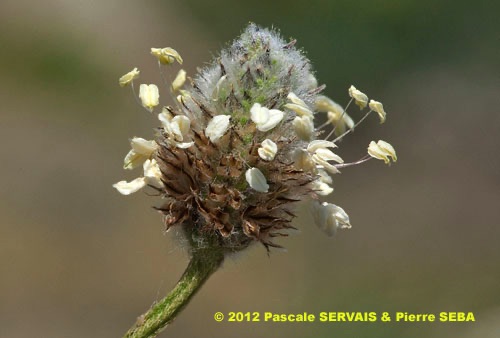
Plantago lagopus L.
Fam. : Plantaginaceae
© Pascale SERVAIS & Pierre SEBA, 2018. Tilo Botanica: Flore de Tilos et du Dodécanèse / Flora of Tilos and of the Dodecanese
English translation by Brenda Bradbury, Howard Bradbury and Stéphane Léonard
Plante herbacée, hermaphrodite, poilue, à racines principales étalées.
Feuilles en rosette à la base, simples, linéaires à lancéolées, entières ou denticulées, de 14 à 30 cm de long, pétiolées, à 3 à 5 nervures très saillantes. Bractées de la base des fleurs ovales, en pointe, membraneuses, velues, avec une ligne noire ou brune sur le dos.
Fleurs à symétrie radiaire, brunes, de 4 mm de diamètre, réunies en épis courts, noirâtres, ovoïdes ou oblongs, de 10 à 25 mm de long, sur une hampe sillonnée, 3 à 5 fois plus longue que la feuille sous-jacente. Corolle à tube lisse, sans poils et à lobes étalés. Calice très velu. 1 style dépassant la corolle et terminé par 1 stigmate. Ovaire supère.
Fruits, capsules globuleuses.
___________________________
Plant herbaceous, hermaphrodite, hairy, with spread out main roots.
Leaves in a rosette at the base, simple, linear to lanceolate, entire or denticulate, from 14 to 30 cm long, petiolate, with 3 to 5 very protruding veins. Bracts of the base of the flowers ovate, pointed, membranous, very hairy, with a black or brown line on the back.
Flowers radially symmetrical, brown, 4 mm in diameter, joined together in short, blackish, ovoid or oblong spikes, from 10 to 25 mm long, on a furrowed pole 3 to 5 times longer than the underlying leaf. Corolla with a smooth tube, without hairs and with spread out lobes. Calyx very hairy. 1 style exceeding the corolla and finished by 1 stigma. Ovary superior.
Fruits, globose capsules.
Descripteurs / Identifying features
1
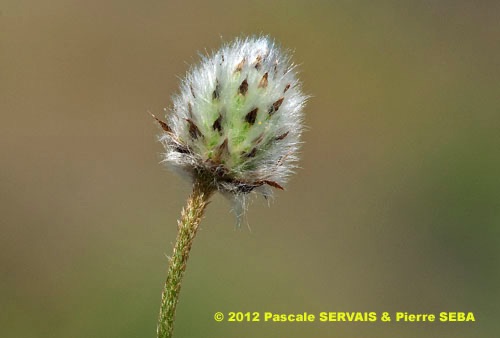
2
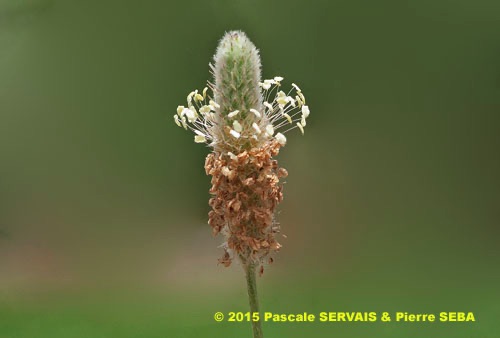
3

4
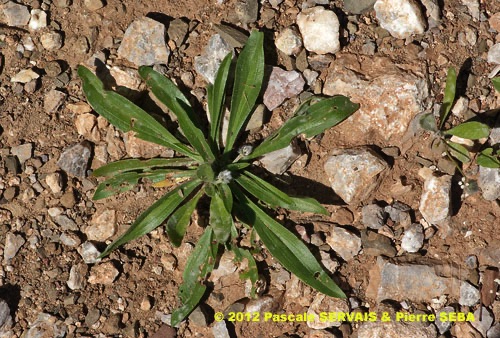
5
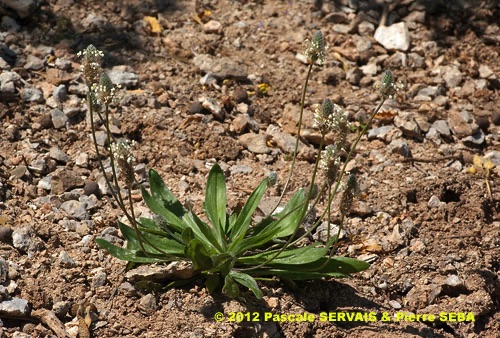
6
Étymologie / Etymology :
Plantago : emprunt du latin plantago, -inis (nom) [ < planta, -ae (nom)
= la plante + ago, -is, -ere (verbe) = faire, agir ] = le plantain, nom
donné à la plante par Pline, naturaliste latin mort en 79 apr. J.-C.,
en référence à ses nombreuses propriétés médicinales.
Lagopus : emprunt du latin lagopus, -odis (nom) = le pied de lièvre,
nom donné à la plante par Pline, naturaliste latin mort en 79 apr. J.-C.,
forme latinisée du grec ancien λαγώπους, -ποδος (nom)
[ < λαγός, -ου (nom) = le lièvre + πούς, ποδός (nom) = le pied ]
= le pied de lièvre, nom donné à la plante par Dioscoride, médecin et
botaniste grec mort en 90 apr. J.-C., en référence à la rosette de
feuilles ressemblant à l’empreinte d’une patte de lièvre.
Plantago : borrowed from Latin plantago, -inis (noun)
[ < planta, -ae (noun) = plant + ago, -is, -ere (verb) = to do, to act ]
= plantain, name given to the plant by Plinius, Latin naturalist died
in 79 AD, referring to its medicinal properties.
Lagopus : borrowed from Latin lagopus, -odis (noun) = foot of hare,
name given to the plant by Plinius, Latin naturalist died in 79 AD,
Latinized form of the Classical Greek λαγώπους, -ποδος (noun)
[ < λαγός, -ου (noun) = hare + πούς, ποδός (noun) = foot ] = foot of
hare, name given to the plant by Dioscorides, Greek doctor and
botanist died in 90 AD, referring to the rosette of the leaves resembling
the footprint of a hare's foot.
Synonymes / Synonyms :
Lagopus arvensis Fourr.
Plantago arvensis C.Presl
Plantago intermedia Lapeyr.
Noms vernaculaires / Common names :
Noms français / French names :
Courtine — Patte-de-lièvre — Pied-de-lièvre —
Plantain pied-de-lièvre.
Noms grecs / Greek names :
Πεντάνευρο — Τσαλαπετεινός — Τσαλαπετινός.
Nom anglais / English name :
Hare’s-foot plantain.
Nom allemand / German name :
Hasenfuß-Wegerich.
Noms espagnols / Spanish names :
Lengua de perro — Pie de liebre.
Nom italien / Italian name :
Piantaggine Pié-di-lepre.
Habitat :
Cultures - Lieux incultes - Sols sableux - Chemins.
Cultivated places - Waste ground - Sandy soils - Waysides.
Île / Island :
Tilos.
Hauteur / Height range :
De 10 cm à 50 cm.
From 10 cm to 50 cm.
Floraison / Flowering time :
De février à juin.
From February to June.
Groupe / Classification :
Dicotylédones.
Dicotyledons.
Pérennité / Lifespan :
Annuelle ou vivace.
Annual or perennial.
Description :
Clés dichotomiques et descripteurs distinctifs des 7 espèces / Dichotomous keys and distinctive identifying features of the 7 species
Photo 1 :
Localisation / Location : Tilos, Livadia, Chemin de Lethra
Date : 18/03/2012
GPS : Lat. 36,42163° N / Long. 27,38804° E / Alt. 48 m
Type : Photographie numérique / Digital Photograph (10 mégapixels)
Photo 2 :
Localisation / Location : Tilos, Livadia, Chemin de Lethra
Date : 18/03/2012
GPS : Lat. 36,42163° N / Long. 27,38804° E / Alt. 48 m
Type : Photographie numérique / Digital Photograph (10 mégapixels)
Photo 3 :
Localisation / Location : Tilos, Megalochorio, Plaine d’Erystos
Date : 25/05/2015
GPS : Lat. 36,44572° N / Long. 27,34904° E / Alt. 24 m
Type : Photographie numérique / Digital Photograph (10 mégapixels)
Photo 4 :
Localisation / Location : Tilos, Megalochorio, Plaine d’Erystos
Date : 25/05/2015
GPS : Lat. 36,44572° N / Long. 27,34904° E / Alt. 24 m
Type : Photographie numérique / Digital Photograph (10 mégapixels)
Photo 5 :
Localisation / Location : Tilos, Livadia, Chemin de Lethra
Date : 18/03/2012
GPS : Lat. 36,42163° N / Long. 27,38804° E / Alt. 48 m
Type : Photographie numérique / Digital Photograph (10 mégapixels)
Photo 6 :
Localisation / Location : Tilos, Livadia, Chemin de Lethra
Date : 18/03/2012
GPS : Lat. 36,42163° N / Long. 27,38804° E / Alt. 48 m
Type : Photographie numérique / Digital Photograph (10 mégapixels)

Google Maps
Google Maps
Google Maps
Google Maps
Google Maps
Google Maps